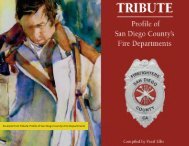Historic Albuquerque
An illustrated history of the City of Albuquerque, New Mexico and the surrounding area, paired with the histories of companies, families and organizations that make the region great.
An illustrated history of the City of Albuquerque, New Mexico and the surrounding area, paired with the histories of companies, families and organizations that make the region great.
Create successful ePaper yourself
Turn your PDF publications into a flip-book with our unique Google optimized e-Paper software.
❖<br />
Above: A panoramic photo of the<br />
Barelas truss bridge across the Rio<br />
Grande, c. 1902. Six men tend a huge<br />
flock of sheep at river's edge.<br />
Wholesale operations that handled<br />
wool and hides had huge warehouses<br />
in <strong>Albuquerque</strong> and Las Vegas where<br />
the products could be shipped by rail<br />
to eastern markets.<br />
COURTESY OF ALBUQUERQUE MUSEUM<br />
PHOTOARCHIVE PA 1999.17.20.<br />
Below: A view of the Santa Fe<br />
Railway shops, c. 1900.<br />
COURTESY OF ALBUQUERQUE MUSEUM<br />
PHOTOARCHIVE PA 1978.50.746.<br />
to speak Spanish, marrying Hispanic women,<br />
and giving their children Spanish first names. By<br />
1870, there were eight Anglo-owned mercantile<br />
establishments in the old plaza.<br />
From its founding, <strong>Albuquerque</strong> has been<br />
closely tied to the Rio Grande. In addition to<br />
being the primary water source for irrigating<br />
the nearby farm fields, the river was also<br />
a barrier for travelers and the transportation<br />
of goods between the town and neighboring<br />
communities. Thus, a convenient and safe<br />
means of crossing the Rio Grande has been of<br />
utmost importance to generations of the town’s<br />
residents. Tom Post, proprietor of the Exchange<br />
Hotel, began a ferry service across the river<br />
in 1874, and in 1876 constructed a pontoon<br />
bridge on the site of the present-day<br />
bridge found on Central Avenue. This<br />
bridge was the first of its kind in the central Rio<br />
Grande Valley.<br />
Post charged a toll for crossing the bridge,<br />
but his enterprise was short-lived when seasonal<br />
floods washed it out. Still realizing the need for<br />
such a structure, the <strong>Albuquerque</strong> Bridge<br />
Company was incorporated in 1879, and they<br />
built another toll bridge across the river. The<br />
tollhouse was ingeniously placed in the middle<br />
of the structure, which allowed traffic from both<br />
directions to pay their fee without the owners<br />
having the additional expense of building and<br />
staffing two stations. Although the bridge was<br />
necessary for year-round travel, the enterprise<br />
was not entirely successful. During low water<br />
levels, people simply forded the river and thus<br />
avoided paying the toll. When the bridge was<br />
needed the most, during the seasonal rainy<br />
season or spring floods, heavy flows often<br />
damaged the bridge causing it to close.<br />
By the end of the 1870s, <strong>Albuquerque</strong> was<br />
entering a new era. The once quiet village along<br />
the east bank of the Rio Grande was on the verge<br />
of becoming literally a “New Town”—not just<br />
socially and economically, but physically as<br />
well. All this was precipitated by an influx of<br />
new civic leaders—not coming from Spain or<br />
Mexico, but from other “foreign” places such as<br />
Kansas and Arkansas—and, of course, by the<br />
arrival of the railroad, perhaps the most<br />
momentous event in <strong>Albuquerque</strong>’s long and<br />
illustrious history.<br />
30 ✦ HISTORIC ALBUQUERQUE
















